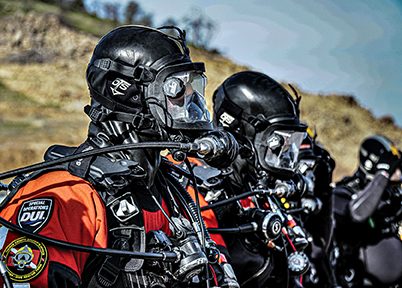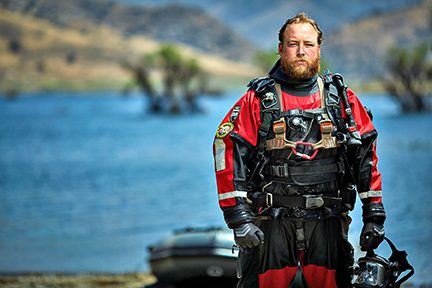THROUGHOUT HISTORY, CRIMINALS HAVE LOOKED TO BODIES of water as safe places to dispose of and forever hide evidence of their crimes. Wherever there is water, there is the potential for criminals to escape punishment by tossing murder weapons or victims into the depths, never to be seen again — or so they thought.
With advancements in forensic science and dive technology, more recoveries of evidence are successfully performed each year. Many items found underwater secure convictions against those who sought to escape justice.
Who Goes Under
When a location requires subsurface investigative resources, the agency leading the investigation will call a specialized dive team. The team may be attached to an existing public service department — such as police, fire, emergency medical services, or a federal agency — and consist of qualified trained divers who perform this task as an additional duty on top of their established role.
Volunteer search-and-recovery teams of certified public safety divers can also be called. These divers may hold a specific skill set required for the location, have experience in that body of water, or can offer additional assistance based on the size and scope of the scene. Many departments do not have enough funding or personnel to dedicate resources to a dive team, especially if their geographical location does not dictate it as a priority.
Public safety divers working as underwater crime scene investigators will operate under the authority of a law enforcement liaison who is present with their team leader. This ensures they follow all elements of proper evidence collection and chain of custody so recovered evidence can be used in court.
Training is crucial for divers to successfully act in a legal capacity as underwater investigators. Instructional agencies such as Emergency Response Diving International (ERDI) and Dive Rescue International (DRI) offer courses to search-and-recovery personnel.
“The reality is that many dive teams are not made up of law enforcement personnel,” said Thomas Powell, an ERDI instructor trainer evaluator and public safety diver. “Public safety divers must learn how to document and handle evidence in a manner that follows standards required by law enforcement and be adequately trained to follow chain-of-evidence protocols and ensure proper evidence collection procedures.”


What Lies Beneath
Underwater crime scene divers slowly, methodically, and precisely follow the directives of their dive tenders on shore and their command support staff on the surface, moving along predetermined search grids and patterns. The work is long and tedious; the divers keep one hand on their tether and move the other outward in a repetitive sweeping motion. Authorities treat every location these divers are called to as a crime scene until it’s proven otherwise. The items the divers recover — such as vehicles, weapons, or human remains — are evidentiary by their presence underwater.
Identification of objects in total blackout conditions using only touch limited by a drysuit glove is difficult, even if you know exactly what you are looking for. Discerning the difference between a segment of human finger bone from a pile of similar-sized bits of tree debris is daunting. Finding a weapon may seem easier but often yields unexpected results. It is not uncommon for divers searching for a firearm to find multiple, none of which match the description of the one being sought.
When an item is discovered and retrieval authorized, they attempt to recover it exactly as found. They encapsulate the item in water at depth, including the sediment and any debris underneath, which can convey pertinent information about its previous environments and the time of year in which the object settled. When objects are disturbed, any trace evidence samples start to degrade from the moment they are handled. Exposure to air amplifies this effect, immediately causing oxidation and eliminating the applicability of various forensic techniques.
Unlike the prevalent actions of internet phenoms who remove license plates from vehicles for video thumbnails or hoist recovered firearms above their heads for social media posts, the true professionals will never simply grab and bring bare evidence to the surface. Nor do they share their personal opinions to the public on cause-of-death factors in open cases involving the recovery of human remains.
“Whenever a body is found in the water, it becomes a cause-of-death investigation,” said Kevin Kemmerling, a DRI corporate instructor and a lieutenant and dive commander for the Tulare County, California, Sheriff’s Office. “There is a proliferation of self-proclaimed ‘professional’ search-and-recovery dive teams popping up across the country who use sensationalist and predatory tactics with victims’ family members to insert themselves into underwater crime scene investigations. These groups lack operational experience and training in industry standards and best practices, and they can ultimately create more emotional distress for victims’ families by giving out incorrect or false information about an active case.”
Recovery of deceased persons in water is among the most difficult tasks underwater crime scene investigators perform. An individual “at rest” in water can stay in motion. In general, after death a body settles and travels to the bottom. During its movement it may encounter wind at the surface and currents in the water column and at depth, which may continue to move the body. Due to postmortem decompositional changes, gas inside the body may cause it to become buoyant and ascend to the surface, leading to additional movement after further encountering site conditions.
After the body completes off-gassing, a final descent will occur. Depending on how long the victim was submerged, the entire body of water and water column within it could be subject to search.
Even if drowning is suspected as the cause of death, authorities must still properly process and investigate the remains. As with object recovery, divers recover soil samples and subsurface material underneath the body’s final resting site. Bullets from a gunshot victim’s body, for example, may have settled into the sediment after having seeped through permeable flesh due to the body’s emulsification in water.
Physical Dangers
With blackout conditions, encounters with aquatic life may happen by contact rather than by sight. Investigators have lost digits to snapping turtles, and officers with rifles often watch over crime scene divers in Florida canals to protect them from alligators.
Not being able to see gives rise to a myriad of entanglement and entrapment hazards. Fishing lines and submerged branches may tangle in a diver’s tether, and more than one investigator has inadvertently traveled into a pipe or natural flow restriction between two bodies of water, becoming trapped by the pressure differential.
Handling evidence in these conditions is dangerous. Deceased persons in aquatic environments release biological material into the water that is hazardous to human health. Firearms handled roughly in the water or not secured properly during collection may inadvertently discharge. Unsecured vehicles can shift and crush divers, and the foam used in some car seats becomes liquified and toxic after extended exposure to water.
Bodies of water may be polluted by chemical pesticides, herbicides, fertilizer, factory runoff, liquid chemicals, human waste, or the odd unidentifiable residue. Exposure to these substances can lead to cancer, birth defects, nervous system failure, and deadly diseases.

Psychological Effects
There are no limits to what an underwater crime scene investigator may encounter at depth. The only guarantee is that they must rely on personal courage, fortitude, and a steel resolve to complete the task at hand. If a slow exploratory sweep causes their drysuit glove to pass through pliable wet flesh and make contact with skeletal components inside a body, panic and bolting to the surface is not an option.
Every scene brings with it mental challenges. Even expected circumstances can cause unexpected reactions, despite previous experience. When a woman intentionally drove her car into a South Carolina lake with her two toddlers inside in 1994, veteran underwater crime scene investigators made the recovery. For one investigator, who had a lifelong passion for recreational scuba diving, seeing the two children still strapped in their car seats ruined his love for the sport, and he never went diving again.
Encountering human remains underwater has a high likelihood of causing psychological trauma. Implementing strategies for prevention beforehand is a key component toward mitigating this risk.
“Despite what you have seen as a first responder, patrolman, or combat veteran, whatever you have seen on land will not compare to what you encounter underwater,” said Patrick O’Boyle, a senior medical instructor at the U.S. Army’s JFK Special Warfare Center and School. “New crime scene divers should meet with their state’s medical examiner to view an underwater cadaver before going on a recovery. Their first experience with one should not be at depth. Crime scene divers should seek support as needed from a counseling professional or teammate — talking to someone will not hurt your job; it will only help you.”
Not at Depth, but Still Under Pressure
For most divers, the dive ends when you reach the surface and return home. For underwater crime scene investigators, the dive continues in a courtroom some months or even years later. Many crime scene divers find the courtroom more stressful than the underwater work. All it takes is one small misstep in the recovery process, chain of custody, or documentation to have the evidence they worked so hard to retrieve to be thrown out of court. Attorneys on both sides fight to admit or dismiss evidence — imagine how easy it might be to instill doubt about the recovery of evidence obtained in blackout water conditions when the divers in question were the only ones present at the scene.
Understanding the professional scrutiny these divers can face, coupled with the dangers and conditions they brave, helps us appreciate this application of diving that’s far beyond the recreational realm. It also invites respect for those divers who perform this job so we don’t have to. AD
© Alert Diver — Q2 2023